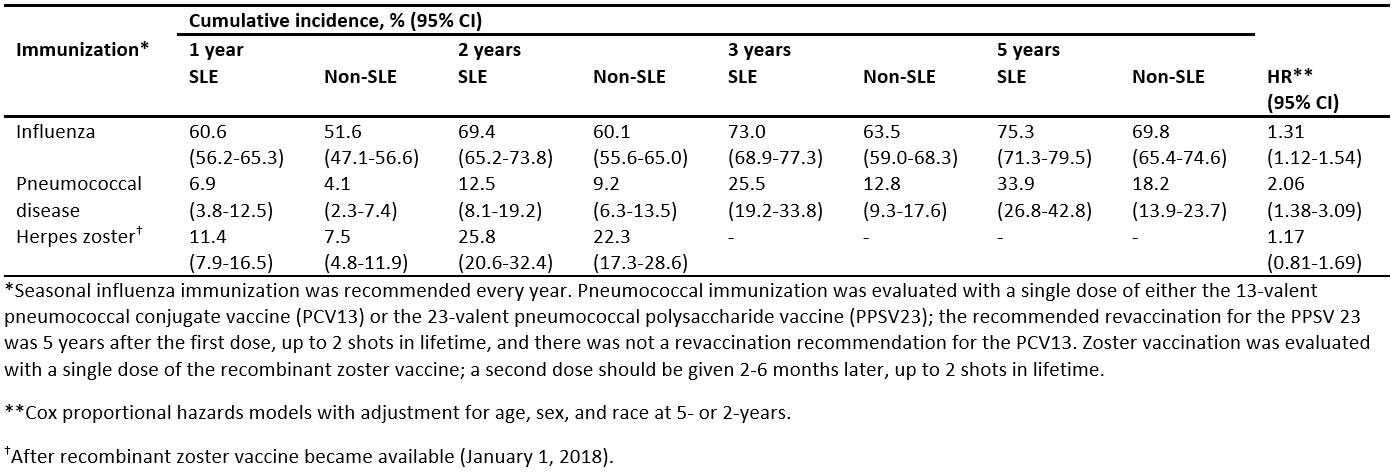Session Information
Date: Saturday, November 12, 2022
Title: Health Services Research Poster I: Lupus, RA, Spondyloarthritis and More
Session Type: Poster Session A
Session Time: 1:00PM-3:00PM
Background/Purpose: Systemic lupus erythematosus (SLE) is a disease that can damage multiple organs and, along with certain treatments, increase the risk of developing cancer, cardiovascular disease, diabetes, osteoporosis, and infections. Preventive services are essential in patients with SLE to mitigate the risks mentioned above. We aimed to evaluate the trends of preventive services utilization in patients with systemic lupus erythematosus compared with the non-SLE population.
Methods: All ≥19-year-old patients with SLE in a population-based cohort on January 1, 2015, were included and matched (1:1) by sex, age, race, and county to non-SLE comparators. Patients with SLE and comparators were followed until February 29, 2020 (due to the beginning of restrictions secondary to the SARS-CoV-2 pandemic), emigration, or death. We evaluated breast and cervical cancer, cardiovascular disease, diabetes mellitus, and osteoporosis screening based on the US Preventive Services Task Force recommendations in effect during 2015-2020. Seasonal influenza, pneumococcal, and herpes zoster vaccination were evaluated following the current recommendations made by the Advisory Committee on Immunization Practices from the Centers for Disease Control and Prevention in the US during the same period. Among both groups, we compared the rates of screenings for breast and cervical cancer, hypertension, hyperlipidemia, diabetes mellitus, osteoporosis, and immunizations. The cumulative incidence was estimated using Aalen-Johansen methods. Cox proportional hazards models with adjustment for age, sex, and race were used to compare screening tests and vaccination rates between the two groups.
Results: We included 440 SLE patients and 430 non-SLE comparators. The trends of provided preventive services in patients with and without SLE are depicted in Table 1. The probability of breast cancer screening among women with SLE was similar to comparators (hazard ratio [HR] 1.09, 95% CI 0.85-1.39, Figure 1A), while cervical cancer screening was lower (HR 0.75, 95% CI 0.58-0.96, Figure 1B). Hypertension screening was higher among patients with SLE (HR 1.35, 95% CI 1.13-1.62, Figure 1C); however, hyperlipidemia screening was similar to comparators (HR 1.16, 95% CI 0.96-1.41, Figure 1D). Diabetes and osteoporosis screenings were more likely to be performed for SLE patients than for comparators (HR 2.46, 95% CI 2.11-2.87, Figure 1E; and HR 3.19, 95% CI 2.31-4.41, Figure 1F; respectively). The trends of vaccine uptake in both groups are depicted in Table 2. Influenza and pneumococcal immunizations were higher among SLE patients (HR 1.31, 95% CI 1.12-1.54; and HR 2.06, 95% CI 1.38-3.09; respectively), while zoster vaccination was similar (HR 1.17, 95% CI 0.81-1.69) than comparators.
Conclusion: The trends of utilization of preventive services by SLE patients vary according to screening or vaccine compared with the general population. Considering the increased risk in this population, we demonstrate an opportunity for improvement, particularly in cervical cancer, hyperlipidemia, and osteoporosis screenings and vaccinations.
To cite this abstract in AMA style:
Chevet B, Figueroa Parra G, Yang J, Hocaoglu M, Osei-Onomah S, Hulshizer C, Gunderson T, CORNEC D, Crowson C, Duarte-Garcia A. Utilization of Preventive Services in a Systemic Lupus Erythematosus Population-Based Cohort: A Lupus Midwest Network Study [abstract]. Arthritis Rheumatol. 2022; 74 (suppl 9). https://acrabstracts.org/abstract/utilization-of-preventive-services-in-a-systemic-lupus-erythematosus-population-based-cohort-a-lupus-midwest-network-study/. Accessed .« Back to ACR Convergence 2022
ACR Meeting Abstracts - https://acrabstracts.org/abstract/utilization-of-preventive-services-in-a-systemic-lupus-erythematosus-population-based-cohort-a-lupus-midwest-network-study/



